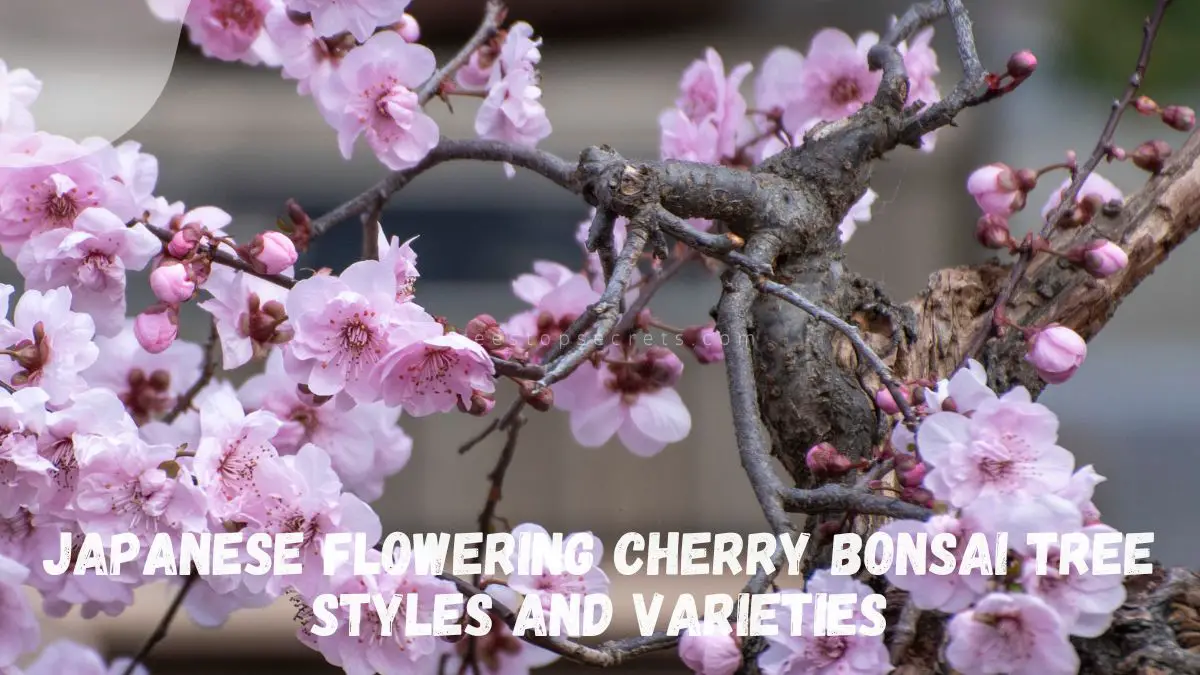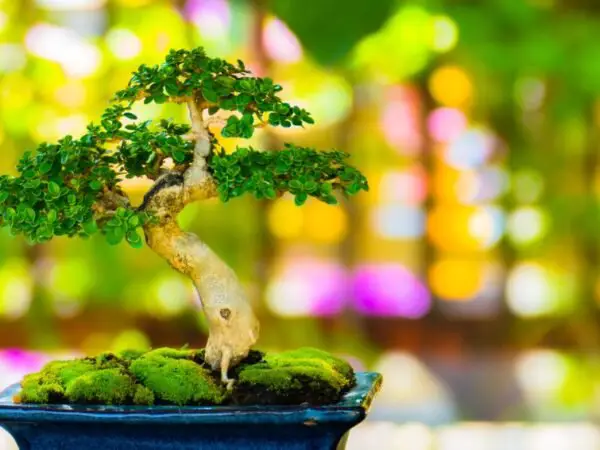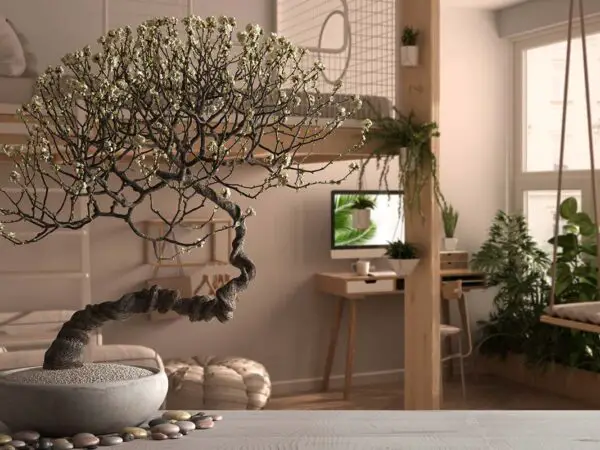Did you know that Japanese flowering cherry bonsai trees can live for over a century when properly cared for? These elegant bonsai cherry design specimens, with their delicate pink blossoms that bloom, are not only stunning but also symbolize beauty, renewal, and the fleeting nature of life. Cultivating a Japanese flowering cherry bonsai tree is a rewarding experience that requires patience, skill, and dedication. Whether you are a seasoned bonsai enthusiast or a beginner looking to try your hand at this ancient art form, the Japanese flowering cherry bonsai tree is a captivating choice that will bring tranquility and beauty to any space.
Key Takeaways
- Care for Success: Regularly prune your Japanese flowering cherry bonsai tree to maintain its shape and health.
- Explore Variety: Discover different styles and varieties of cherry bonsai trees to find the one that suits your preferences.
- Start Strong: Beginners should focus on basic cultivation tips like proper watering and sunlight exposure.
- Level Up: Advance your bonsai skills with techniques such as wiring and branch bending for intricate designs.
- Showcase Creativity: Experiment with creative display ideas to enhance the aesthetic appeal of your cherry bonsai tree.
- Community Connection: Engage with the bonsai community to learn, share experiences, and grow your knowledge.
Understanding Japanese Flowering Cherry Bonsai Trees
Origins and Significance
Japanese flowering cherry bonsai trees have a rich history dating back to the 14th century in Japan. Originally cultivated by the Japanese elite, these bonsai trees symbolize beauty, grace, and the transient nature of life. The practice of growing cherry blossom bonsai trees has deep cultural roots in Japan, where they are revered for their delicate flowers that represent renewal and the fleeting nature of existence.
The art of cultivating Japanese flowering cherry bonsai trees has evolved over centuries, blending traditional techniques with modern innovations. This evolution has led to a diverse range of styles and approaches to bonsai cultivation, showcasing the adaptability and creativity within this ancient art form.
Unique Features
Japanese flowering cherry bonsai trees are renowned for their exquisite beauty and unique characteristics. These bonsai trees stand out due to their stunning pink or white blossoms that bloom in clusters, creating a mesmerizing display reminiscent of springtime in Japan. Unlike other varieties, cherry blossom bonsai trees exhibit a graceful elegance in both their appearance and growth patterns.
The distinctive features of Japanese flowering cherry bonsai trees make them highly sought after by enthusiasts and collectors worldwide. Their ability to evoke a sense of tranquility and natural beauty sets them apart from other types of bonsai trees, making them a prized addition to any collection.
Growth and Care Basics
To successfully grow and care for Japanese flowering cherry bonsai trees, it is essential to provide the right conditions and maintenance. These bonsai trees thrive in well-draining soil with adequate sunlight exposure and consistent watering. Proper fertilization is crucial for promoting healthy growth and vibrant blooms.
Maintaining the health and vitality of Japanese flowering cherry bonsai trees requires regular pruning to shape the tree and encourage new growth. By following proper pruning techniques and ensuring balanced growth, enthusiasts can enjoy the beauty of these bonsai trees for years to come. Attention to detail in watering schedules and fertilization routines is key to sustaining the vigor and resilience of these delicate trees.
Care Guidelines for a Thriving Bonsai
Watering Practices
Japanese flowering cherry bonsai trees require careful watering to thrive. In spring and summer, water frequently to maintain moisture levels. During fall and winter, reduce watering to prevent root rot. Overwatering can lead to root suffocation and fungal diseases, while underwatering causes dehydration and wilting. To ensure optimal hydration, check the soil moisture regularly and adjust watering accordingly.
Sunlight and Placement
For Japanese flowering cherry bonsai trees, direct sunlight is essential for healthy growth. Place them in a spot receiving at least six hours of sunlight daily. Insufficient sunlight can result in weak growth and poor flowering. Create a suitable environment by positioning the bonsai where it can receive ample natural light throughout the day. Adequate sunlight exposure encourages vibrant blooms and overall vitality.
Pruning Techniques
Pruning is crucial for maintaining the shape and health of Japanese flowering cherry bonsai trees. Regular pruning helps control growth and promote flowering. Timing is key; prune during early spring or late fall for best results. Use sharp, clean tools to make precise cuts and avoid damaging the tree. Careful pruning encourages lush foliage and enhances the tree's aesthetic appeal.
- Pros of Pruning:
- Promotes healthy growth
- Enhances the tree's appearance
- Cons of Pruning:
- Risk of over-pruning
- Potential for stress on the tree
Seasonal Care Tips
Adapting care routines based on seasonal changes is vital for the well-being of Japanese flowering cherry bonsai trees. In spring, focus on fertilizing to support new growth. Summer requires increased watering due to higher temperatures. Fall is ideal for pruning to prepare for winter dormancy. Winter care involves protecting the tree from frost by insulating the roots. By adjusting care practices according to each season, you ensure your bonsai thrives year-round.
General Information on Cherry Bonsai
Species Overview
Japanese flowering cherry bonsai trees are typically cultivated from species like Prunus serrulata and Prunus incisa. These species exhibit delicate pink or white blossoms, making them popular choices for bonsai enthusiasts. Their compact size and graceful appearance make them ideal for bonsai cultivation.
Prunus serrulata, also known as the Japanese cherry or sakura, is favored for its abundant flowers that symbolize renewal and the ephemeral nature of life. On the other hand, Prunus incisa, or Fuji cherry, features smaller leaves and a more compact growth habit, suitable for creating intricate bonsai designs. Each species offers unique characteristics that influence their suitability for bonsai artistry.
When comparing these cherry tree species, consider factors like bloom color, leaf size, and growth patterns. Prunus serrulata's larger flowers and symbolic significance may appeal to those seeking a traditional aesthetic, while Prunus incisa's compact form is favored for its ease of styling and maintenance in bonsai cultivation.
Cultural Importance
Japanese flowering cherry bonsai trees hold immense cultural significance in Japan, deeply rooted in traditions and artistic expressions. These bonsai trees are revered for their connection to hanami (flower viewing) festivals, where people gather to admire the fleeting beauty of cherry blossoms. The delicate blooms symbolize transience and the arrival of spring.
In Japanese culture, cherry blossoms represent purity, beauty, and the fragility of life. Artists often depict these blossoms in paintings, poetry, and literature as a metaphor for the ephemeral nature of existence. Bonsai artists meticulously shape and care for cherry bonsai trees to capture the essence of nature's beauty in miniature form.
Cherry blossoms feature prominently in traditional Japanese art forms like ikebana (flower arranging) and ukiyo-e (woodblock prints), reflecting the enduring allure of these delicate flowers. The intricate beauty of cherry bonsai trees mirrors Japan's reverence for nature and the harmonious balance between human artistry and natural aesthetics.
Common Challenges
Growers cultivating Japanese flowering cherry bonsai trees may encounter challenges such as pest infestations, diseases, and environmental stressors that affect tree health. Pests like aphids and spider mites can damage foliage, while diseases like powdery mildew can impact overall tree vitality. Maintaining proper watering, humidity levels, and ventilation can help prevent these issues.
To address common challenges, growers should regularly inspect their bonsai trees for signs of pests or diseases. Implementing integrated pest management practices and using organic remedies can effectively control infestations without harming the tree or surrounding environment. Providing adequate sunlight exposure and appropriate soil moisture levels is crucial for promoting tree resilience.
Styles and Varieties of Cherry Bonsai
Traditional Styles
Japanese flowering cherry bonsai trees are shaped using traditional bonsai styles like the formal upright, informal upright, and slanting styles. These techniques emphasize balance, harmony, and natural beauty. The influence of Japanese aesthetics is evident in the meticulous shaping and pruning of these bonsai trees to mimic the grace and elegance of full-sized cherry blossom trees. Enthusiasts often showcase traditional bonsai styles for cherry blossom trees at exhibitions and competitions.
Popular Varieties
Among the cherry tree cultivars, some popular varieties for Japanese flowering cherry bonsai trees include the Yoshino cherry, Kwanzan cherry, and Autumnalis cherry. Each variety has unique features such as flower color, bloom time, and growth habits that appeal to bonsai enthusiasts. The Yoshino cherry is known for its delicate white flowers, while the Kwanzan cherry stands out with its double-petaled pink blooms. These varieties, such as cherry tree bonsai, are favored for their aesthetic appeal and symbolic significance in Japanese culture.
Unique Characteristics
Japanese flowering cherry bonsai trees exhibit unique characteristics such as their graceful branching patterns, vibrant pink or white blossoms, and small glossy leaves. These traits capture the essence of springtime beauty in a miniature form. The cultural significance of cherry blossom bonsai trees is deeply rooted in Japanese traditions, symbolizing renewal, beauty, and the transient nature of life. The allure of these bonsai trees lies in their ability to evoke emotions of peace and serenity through their exquisite beauty.
Exploring Specific Types
Makoto's Cherry Tree
Makoto's Cherry Tree stands as a renowned and cherished example of Japanese flowering cherry bonsai. Its history traces back to the skilled hands of bonsai master Makoto Azuma. The tree's legacy in the world of bonsai cultivation is unparalleled, symbolizing artistry and dedication.
The cultural impact of Makoto's Cherry Tree extends beyond its botanical beauty. It serves as a symbol of patience, resilience, and the harmonious relationship between humans and nature. This iconic bonsai tree embodies the essence of traditional Japanese aesthetics and craftsmanship.
Sakura Bonsai
Sakura Bonsai represents the art and tradition of cultivating Japanese flowering cherry trees in miniature form. The symbolic significance of cherry blossoms in Japanese culture is profound, symbolizing renewal, beauty, and the transient nature of life. The meticulous care and attention to detail required in cultivating Sakura Bonsai reflect the reverence for nature in Japanese art.
The beauty of Sakura Bonsai lies in its ability to capture the essence of natural harmony within a small container. Each delicate blossom on the miniature tree evokes a sense of tranquility and appreciation for the fleeting beauty of nature. As a representation of grace and elegance, Sakura Bonsai holds a special place in the hearts of bonsai enthusiasts worldwide.
Cherry Blossom Bonsai
Cherry Blossom Bonsai transports enthusiasts into an enchanting world filled with cultural significance and artistic expression. The intricate process of cultivating and caring for cherry blossom bonsai trees requires meticulous attention to detail and a deep understanding of horticulture. Each delicate petal and branch symbolize the impermanence of life and the beauty found in fleeting moments.
The ephemeral beauty of cherry blossoms in bonsai art captures the essence of seasonal cycles and the passage of time. As symbols of new beginnings and renewal, cherry blossom bonsai trees evoke a sense of wonder and appreciation for the transient nature of existence. Their presence in bonsai collections adds a touch of poetic elegance and cultural depth.
Timelapse Cherry Bonsai
Witnessing the mesmerizing transformation of a cherry bonsai tree through a timelapse video offers a unique perspective on the growth stages and blooming process. These videos capture the seasonal changes that unfold over weeks or months, showcasing the tree's evolution in a condensed format. For bonsai enthusiasts, timelapse videos provide educational insights into the development and care practices involved in nurturing these miniature marvels.
The educational value of timelapse videos extends to inspiring novice growers to embark on their bonsai journey with confidence. By observing the gradual changes in a cherry bonsai tree, enthusiasts gain a deeper appreciation for the patience and dedication required to cultivate these living works of art.
Cultivation Tips for Beginners
Selecting Your Bonsai
When choosing a Japanese flowering cherry bonsai tree, consider your preferences and skill level. Look at factors like size, age, and style to match your taste and experience. Evaluate the health and quality of the tree before purchasing to ensure its long-term growth.
- Size, age, and style are crucial in selecting a bonsai tree.
- Examining the health and quality of the tree is essential for its longevity.
- Personal preferences play a significant role in choosing the right bonsai tree.
Essential Tools and Supplies
To care for your Japanese flowering cherry bonsai tree, you'll need essential tools. These include scissors, wire cutters, concave cutters, and root hooks. Each tool serves a specific purpose in maintaining and styling your bonsai. High-quality tools enhance the overall cultivation experience.
- Scissors, wire cutters, and concave cutters are vital for pruning.
- Root hooks help with root maintenance and repotting.
- Quality tools improve precision and efficiency in bonsai care.
Initial Potting and Repotting
Potting and repotting are critical processes for Japanese flowering cherry bonsai trees. Timing is key when repotting to avoid stressing the tree. Techniques like root pruning promote healthy growth. Follow step-by-step instructions for potting and repotting to ensure your bonsai's stability and well-being.
- Timely repotting prevents root-bound conditions.
- Root pruning during repotting aids in promoting new growth.
- Proper potting techniques are essential for the bonsai's stability.
Advanced Care Techniques
Fertilization Strategies
Japanese flowering cherry bonsai trees require strategic fertilization to thrive. Use balanced fertilizers with equal NPK ratios for healthy growth. Apply fertilizer sparingly to avoid root burn, especially during the growing season.
- Choose slow-release fertilizers for sustained nutrition.
- Adjust fertilization frequency based on the tree's development stage.
- Avoid over-fertilizing to prevent nutrient imbalances and root damage.
Creating a customized fertilization routine is crucial. Start with a spring application of balanced fertilizer to support new growth. Transition to a nitrogen-rich formula in summer for leaf development. As fall approaches, switch to a potassium-based fertilizer to enhance flower bud formation.
Pest and Disease Management
Pests like aphids and spider mites can harm Japanese flowering cherry bonsai trees. Look out for yellowing leaves or webbing as signs of infestation. To combat pests:
- Introduce beneficial insects like ladybugs to control aphids.
- Use neem oil or insecticidal soap as organic remedies against pests.
- Prune affected areas and dispose of infected leaves to prevent further spread.
For diseases such as powdery mildew or root rot, maintain proper air circulation around the bonsai tree. Treat fungal infections with copper fungicides or sulfur-based products. Regularly inspect your bonsai for early detection of any issues.
Winter Protection
Winter poses challenges for Japanese flowering cherry bonsai trees due to frost and cold winds. Protect your bonsai by:
- Placing them in a sheltered location away from harsh weather conditions.
- Mulch the soil surface to insulate roots from freezing temperatures.
- Reduce watering frequency during winter to prevent root rot in dormant trees.
Establish a winter care routine by gradually reducing fertilizer applications in late autumn. Prune excess foliage to promote airflow and minimize snow accumulation on branches. By providing adequate winter protection, you ensure the survival and vitality of your cherished bonsai tree.
Creative Display Ideas
Indoor Display Tips
When displaying Japanese flowering cherry bonsai trees indoors, ensure they receive adequate lighting. Place them near a window where they can get indirect sunlight. Maintain a consistent temperature between 60-75°F for optimal growth.
For indoor cultivation, humidity is crucial. Mist the tree regularly to keep the air moist around it. Consider using a humidity tray filled with water and pebbles to increase moisture levels.
To enhance the aesthetic appeal of indoor bonsai displays, use decorative pots that complement the tree's beauty. Consider adding small figurines or stones to create a serene miniature landscape.
Outdoor Presentation
Showcasing Japanese flowering cherry bonsai trees in outdoor settings allows them to benefit from direct sunlight, promoting healthy growth and vibrant blooms. Ensure the tree receives at least 6 hours of sunlight daily.
Outdoor cultivation provides better airflow, reducing the risk of pests and diseases. Position your bonsai tree in a spot with good air circulation to maintain its health and vigor.
When selecting outdoor locations for your bonsai display, choose areas with natural elements like rocks or water features to create a harmonious setting. Consider using different levels of elevation for an interesting visual impact.
Seasonal Decoration
Get creative with seasonal decoration ideas for your Japanese flowering cherry bonsai tree. During spring, adorn your tree with tiny blossoms or cherry blossom-themed decorations to celebrate the season.
In summer, incorporate miniature beach chairs or umbrellas to create a relaxing summer vibe around your bonsai tree. Enhance the display with small lanterns or colorful leaves during autumn.
As winter approaches, decorate your bonsai tree with tiny snowflakes or miniature holiday lights to bring a festive touch to your indoor space. Rotate seasonal decorations throughout the year to keep your display fresh and engaging.
Joining the Bonsai Community
Local Clubs and Societies
Local bonsai clubs and societies offer a supportive environment for bonsai beginners to learn and grow. Engaging with these communities provides opportunities for hands-on workshops, where enthusiasts can gain practical skills in cultivating Japanese flowering cherry bonsai trees. networking with experienced growers allows beginners to seek guidance and advice on nurturing their bonsai creations.
Joining local bonsai clubs and societies is not just about learning; it's also a chance to share experiences with like-minded individuals who share a passion for bonsai cultivation. These communities often organize group activities such as tree styling demonstrations, garden visits, and exhibitions, fostering a sense of camaraderie among members. For those starting their journey with Japanese flowering cherry bonsai trees, this communal support can be invaluable.
To find and connect with local bonsai clubs and societies, attend horticultural events, visit botanical gardens, or inquire at local nurseries specializing in bonsai. Many clubs have online presence through websites or social media platforms, making it easier to reach out and get involved in the vibrant world of bonsai cultivation.
Online Forums and Resources
For bonsai enthusiasts seeking continuous learning and interaction, online forums and resources dedicated to Japanese flowering cherry bonsai trees are treasure troves of information. Participating in these virtual communities allows beginners to access expert advice, troubleshooting tips, and insights on advanced techniques from seasoned growers worldwide.
Engaging in online bonsai communities offers the advantage of 24/7 support, enabling enthusiasts to seek guidance at any time. These platforms serve as hubs for sharing photos of bonsai creations, discussing challenges, and celebrating successes within the community. Some popular websites, forums, and social media groups for bonsai enthusiasts include:
- Bonsai Nut Forum
- Reddit's r/Bonsai community
- American Bonsai Society website
Exhibitions and Shows
Bonsai exhibitions and shows featuring Japanese flowering cherry bonsai trees are not only visually captivating but also educational experiences for enthusiasts. These events showcase the artistry and craftsmanship behind each meticulously crafted bonsai tree, inspiring viewers with the beauty of nature captured in miniature form.
Attending bonsai exhibitions provides insight into different styles of bonsai design, from traditional to contemporary interpretations. It also offers a platform for enthusiasts to engage with experienced growers, gather tips on tree care, and witness live demonstrations of pruning and styling techniques. By immersing oneself in the world of bonsai shows, enthusiasts can deepen their appreciation for the art form while connecting with fellow aficionados.
Summary
You've learned the essentials of caring for your Japanese flowering cherry bonsai tree, from understanding its unique characteristics to mastering cultivation and advanced care techniques. By exploring different styles, varieties, and creative display ideas, you're equipped to showcase the beauty of your bonsai with confidence. Joining the bonsai community will further enrich your journey, allowing you to exchange tips and experiences with fellow enthusiasts. Keep nurturing your bonsai with dedication and creativity to enjoy a thriving and visually stunning miniature tree in your space.
Frequently Asked Questions
What are the key characteristics of Japanese Flowering Cherry Bonsai Trees?
Japanese Flowering Cherry Bonsai Trees are known for their delicate pink or white blossoms, creating a stunning display. They require meticulous care to maintain their compact size and elegant appearance.
How often should I water my Japanese Flowering Cherry Bonsai Tree?
Water your Japanese Flowering Cherry Bonsai Tree when the topsoil starts to feel slightly dry. Ensure thorough watering but avoid waterlogging, as proper hydration is crucial for the tree's health and vibrant blooms.
What is the ideal lighting condition for Cherry Bonsai Trees?
Cherry Bonsai Trees thrive in bright, indirect sunlight. Place them near a window where they can receive ample natural light throughout the day. Protect them from harsh midday sun to prevent leaf burn.
Should I prune my Cherry Bonsai Tree regularly?
Regular pruning is essential for maintaining the shape and health of your Cherry Bonsai Tree. Trim back new growth to encourage branching and promote a compact, aesthetically pleasing form. Pruning also helps improve air circulation and light penetration.
How can I protect my Cherry Bonsai Tree from pests and diseases?
Inspect your Cherry Bonsai Tree regularly for signs of pests like aphids or diseases such as powdery mildew. Use organic insecticidal soap or neem oil to treat infestations. Proper ventilation, good hygiene practices, and maintaining optimal growing conditions can help prevent issues.
Image Source: Paid image from CANVA





